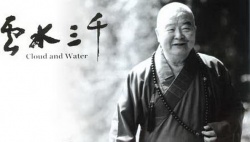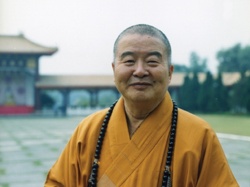Master Hsing Yun
Hsing Yun (TC: 星雲大師; Hanyu Pinyin: Xīngyún Dàshī) (July 22, 1927-) is a renowned Chinese Buddhist monk, as well as an important figure in modern Mahayana Buddhism.
As the founder of the Fo Guang Shan Buddhist Order, one of the largest religious and humanitarian organization in the Republic of China, he is well known and recognized in the international Buddhist community for his humanitarian work, calligraphy, Dharma propagation, and writing. As an active philanthropist, Hsing Yun contributes in pushing forth the ideal of Humanistic Buddhism, a modern Buddhist philosophy preached by many modern teachers of the Buddhist faith. He is well-known among Chinese Buddhists around the world and has received praise from many teachers. So far, more than 5,000 monastic disciples have been tonsured under Hsing Yun, with over a million lay followers worldwide.
Hsing Yun is a forty-eighth generation lineage holder of the Linji Chan (Rinzai Zen) school through Master Zhi Kai, his teacher.
Starting in the 1950s, Hsing Yun started making many achievements at an early age. He taught numerous classes, built many schools for children, recorded the first Buddhist hymns, and was promoted as an executive in many Buddhist associations. In 1957, Hsing Yun established a Buddhist cultural center in which a variety of Buddhist books are published with training tools such as audio and visual aids. In 1959, Hsing Yun also supported the Tibetan movement against communist suppression, and organized the first float parade in celebration of Wesak in Taiwan.
Perhaps one of Hsing Yun's influential achievements was his push for Wesak to become a national holiday in Taiwan, a wish that had been granted by former ROC President Lee Teng-hui in 2000. However, it is not celebrated officially by all of the people in the ROC.
Hsing Yun was one of eight venerables who proposed the World Buddhist Forum in China in 2004, a suggestion that won support from Buddhist circles in countries like Japan and the Republic of Korea.
Expansion of the Dharma
In 1967, Hsing Yun purchased more than 30 hectares in Ta Shu Township, Kaohsiung County as the site for the construction of a monastery. The groundbreaking ceremony was held on May 16th. He began by building the colleges and their dormitories, and working slowly towards building the shrines.
During that time that was spent clearing the mountains, the endless toiling away, wave upon wave of physical strain, the planning that carried on into all hours of the day, the barrage of floods and other natural disasters, and the belligerent mobs that surrounded the mountain were all quite beyond description. On windy and sunny days, the workers clothes would be soaked in sweat, dried up, and then soaked up again. They would be discussing throughout the day and go to bed late at night, and then as soon as the sun came out, they would work again. However, in the momentum of an incomparable courage, and by the blood and sweat of the laborers, the vast wilderness was transformed into the scenic Fo Guang Shan today.
Soon after the building of Fo Guang Shan, many countries, including most parts of Taiwan, each had their own Fo Guang Shan branch temple. Hsi Lai Temple (USA), Nan Tien Temple (Australia), and Nan Hua Temple (South Africa) are among the biggest branch temples. Fo Guang Shan branch temples can be found in the United States, Canada, Brazil, Japan, Hong Kong, Thailand, Malaysia, Australia (Brisbane and Wollongong), France, the Netherlands, South Africa, New Zealand and the United Kingdom.
Venerable Master Hsing Yun was born in 1927, in Jiangdu, Jiangsu Province, China. At the age of twelve, he became ordained under the eminent Master Zhi Kai in Nanjing. He had undertaken studies at various monasteries and had the privilege to encounter numerous grand masters.
He arrived in Taiwan in 1949 and undertook the role of chief editor of the publications 'Human Life', 'Buddhism Today', 'Awakening the World' and other magazines. In 1952, he establish the Ilan Buddhist Chanting Group, Youth Group, Sunday School and the Dharma Propagation Group; hence grounding a strong foundation for his subsequent endeavors in the promotion of the Dharma.
In 1957, he established the Buddhist Literature Center, which later became known as Fo Guang Publishing House. Venerable Master Hsing Yun founded Fo Guang Shan Monastery in 1967, with the vision to promote Humanistic Buddhism and instill the practice of propagating Buddhism through culture; fostering talent through education; benefiting society through charitable programs and purifying the human mind through Buddhist practice. In order to take Buddhism on the journey to modernisation, he has established guidelines that embrace both tradition and modern day practices.
He has since expanded the Fo Guang Shan Monastery to now consist of over two hundred branch temples in major cities around the world. In particular, Hsi Lai Temple near Los Angeles, Nan Tien Temple in Sydney and Nan Hua Temple in South Africa are renowned as the largest Buddhist temples in North America, Australia and Africa respectively. In addition, nine art galleries, twenty-six libraries, more than three publishing houses, twelve bookstores, the Cloud and Water Mobile Clinic, over fifty Chinese language schools, sixteen Buddhist colleges, three Secondary Schools and three Universities have been established. In 2002, Hsi Lai University was awarded affiliated membership to the WASC; it being the very first Chinese based and run university in USA to be honored in such a manner. A Children's Home, Fo Guang Nursing Home and Fo Guang Shan Charity Trust were also established in 1970, 1975 and 1987 respectively to nurture the young, care for the old, support the weak and provide financial assistance to the needy.
Venerable Master's other accomplishments include instigating the publication of the Fo Guang Academic Journal in 1976. In subsequent years, 'Fo Guang Tripitaka', 'Fo Guang Buddhist Dictionary', 'Universal Gate Buddhist Journal', 'A Collection of Contemporary Buddhist Thesis' and other works were published. In addition, the Buddha's Light Television network was established in 1997, and the first Buddhist daily newspaper 'Merit Times' was launched in 2000.
Venerable Master Hsing Yun is an accomplished author, having written a number of works, such as Being Good, Lotus in a Stream, Buddhism: Core Ideas, Only a Great Rain, Where is Your Buddha Nature?, The Lion's Roar, Wise Thoughts, Modern Mentality, Hsing Yun's Chan Talk, Between Ignorance and Enlightenment and many other titles. They have been translated into over ten foreign languages, including English, Japanese, German, French, Spanish, Korean, Thai and Portuguese and have enjoyed extensive circulation worldwide. Venerable Master's propagation of the Dharma has been widespread, having ordained over one thousand monastic and attracted millions of lay Buddhist devotees around the globe. He has dedicated his life to the propagation of Humanistic Buddhism and has advocated the ideal of caring for the earth and pertaining to the universe. Joy and Harmony, Oneness and Coexistence, Respect and Magnanimity and Peace and Equality are the concepts that he has been actively promoting. They form the guidelines for members of the Buddha's Light International Association, which was established in 1991. The association is present in over one hundred and seventy-three countries worldwide, making it the largest Chinese association in the world and as such, fully realising the ideal of the Buddha's Light illuminating the three thousand realms and Dharma water flowing across the five continents. In 2003, BLIA was formally recognised and esteemed by the United Nations, hence gaining inclusion into the NGO.
Venerable Master's achievements have been recognised by the government of Taiwan, and international communities. He has been awarded Honorary Phd. titles by Universities in USA, Thailand and Korea. In 2000, Venerable Master Hsing Yun was presented with the National Social Welfare Award in affirmation of Venerable Master's contribution to the nation, society and Buddhism. Venerable Master has also convened with His Holiness Pope John Paul II and the Dalai Lama in 1997 to exchange ideas in the quest to realise world peace. In order to revive the Theravada tradition of taking Bikkhuni Precepts, which has been forgotten for more than a thousand years, in 1998 Venerable Master held the Full Ordination Ceremony in Bodhgaya, India. In November 2004, the Full Ordination Ceremony to transmit the precepts of the Mahayana tradition will be held at Nan Tien Temple in Australia.
Other significant events that have arisen through Venerable Master Hsing Yun's effort include the enshrinement of one of the three Buddha's tooth relics remaining at Fo Guang Shan, and the sole Buddha's finger relic tour to Taiwan, which was made possible through his successful negotiation with China's Chairman Jiang Ze-Min. This significant event marked a new page in the history of religious exchange between China and Taiwan, bringing closer peaceful interactions between the two shores. Later on, he led the Choir of Fo Guang Shan Monastic Order on a performance tour to Beijing and Shanghai. In February 2004, Buddhist orders across the straits collaboratively formed the Buddhist Hymn Performance Troupe, which toured countries including Taiwan, Hong Kong, Australia, USA and Canada, hence turning a new leaf in the propagation of Buddhism in the quest to promote world peace.
Venerable master has indeed made tremendous contributions to Buddhism, in regulating its practice and propagating its teachings, in making it relevant to modern day society and applicable to daily life, and in spreading its teachings worldwide!
Awards and recognitions
- 1978- Honorary Ph.D. by the University of Oriental Studies in Los Angeles
- 1979- Taiwan's Social Education Construction Award
- 1980- Promoted "Guiding Master" for the Buddhist Association of Taiwan
- 1981- Promoted World Buddhist Sangha Council executive member
- 1982-Awarded the Award of Excellence for Public Welfare Social for ReligiousOrganizations and Indiviuals, appointment from Taiwan's Chinese CultureUniversity
- 1984- Awarded for meritorious service in social education
- 1985- Elected honorary president of the World Fellowship of Buddhist Youths (WFBY)
- 1986- Becomes honorary citizen of Kaohsiung, Taiwan
- 1988- Becomes honorary citizen of Alhambra, California
- 1989- Awarded the Golden Bell Award for his aired Dharma lecture on TTV
- 1992- Elected permanent honorary president of the World Fellowship of Buddhists
- 1990- Awarded the Golden Tripod Award for the directed compilation of the Fo Guang Buddhist Dictionary
- 1992- South Africa grants land as an award to Fo Guang Shan (land used to build Nan Hua Temple), Awarded the Gentle Breeze Award and Outstanding Social Improvement Award, becomes honorary citizen of Austin, Texas, presented a certificate of appreciation from March Fong Eu, the California Secretary of State
- 1994- Austin, Texas declares September 10 to be Austin Fo Guang Day, presented a key to the city from then Mayor Gus Garcia
- 1997-Awarded the Social Construction Award for the airing of the TV film "Lotus Heart" on CTV, earns first class medals from the Ministry of the Interior and Ministry of Foreign Affairs in Taiwan, earns the Hua Xia medal, the highest medal given to a citizen of Taiwan
- 1998- Honorary citizen of Houston, Texas, declared Houston Fo Guang Day on June 20th
- 1999- Awarded the National Public Welfare award from President Lee Teng-hui
- 2000- Hsing Yun's book "Historias Ch'an" becomes number one on the bestseller book chart in Brazil
- 2003- Honorary Ph. D from Maha Chulalongkorn Buddhist University

